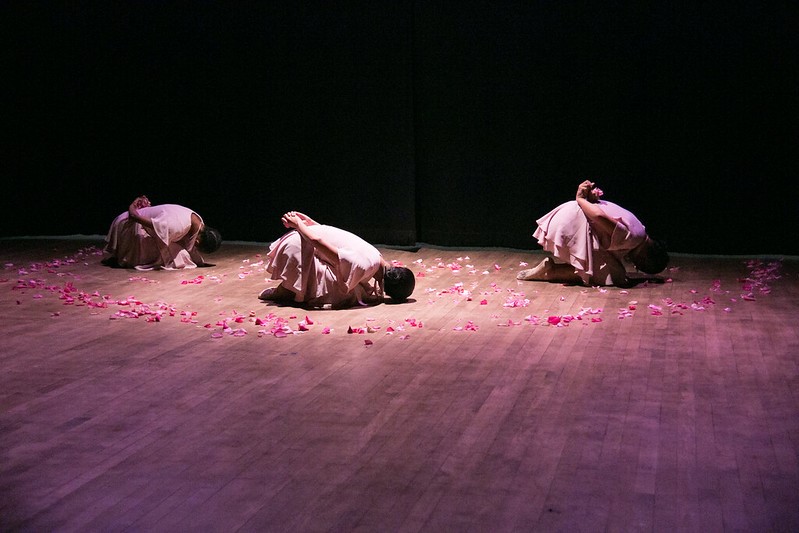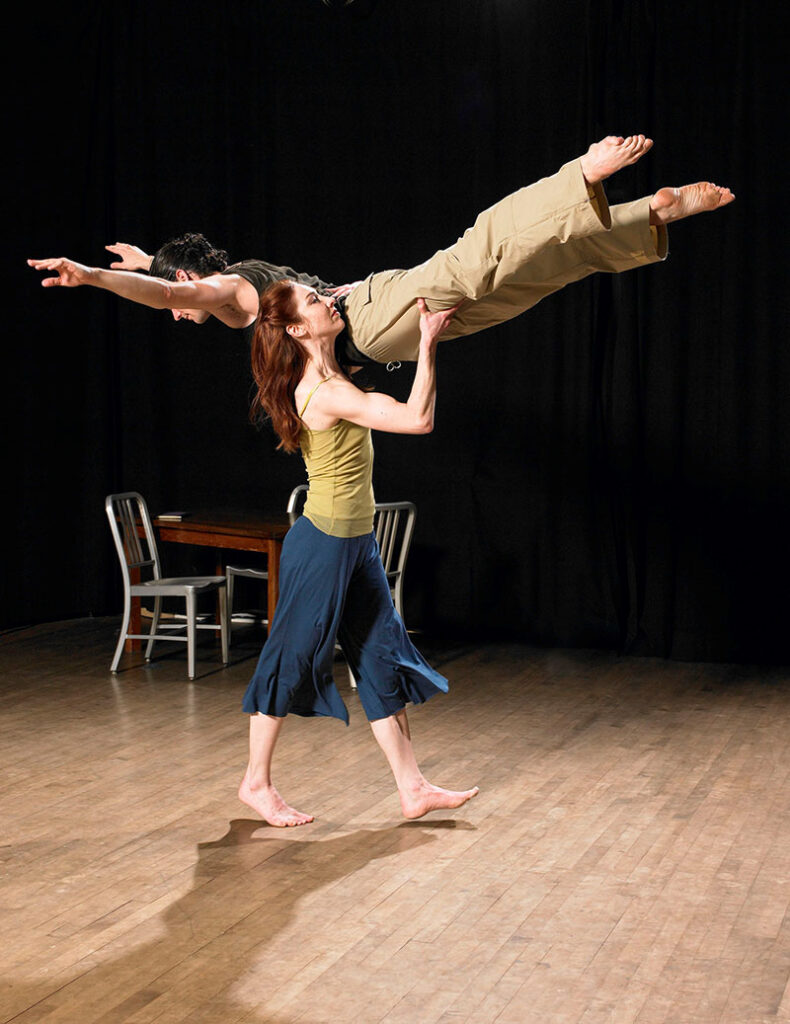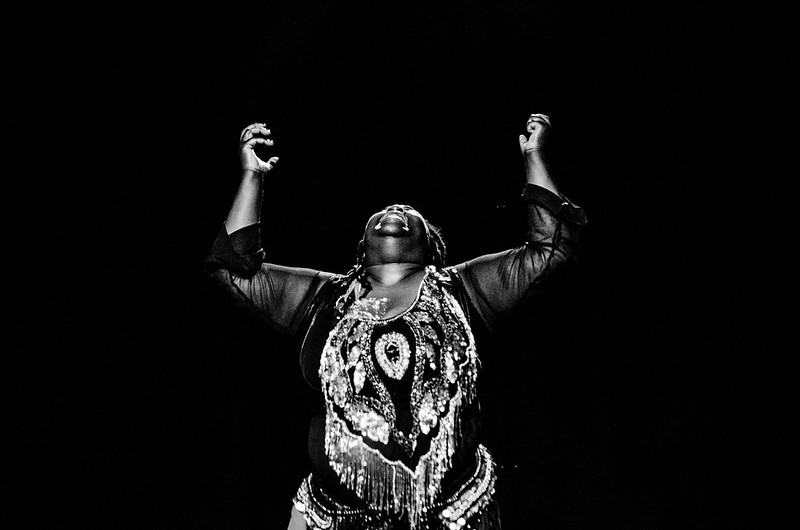“People Come into the Room and Make Work”
An Interview with Deborah Slater about Studio 210
BY EMMALY WIEDERHOLT
Deborah Slater is a choreographer in San Francisco and the force behind Studio 210, a performance, rehearsal, and residency space. Since its founding in 1980, hundreds of teachers, choreographers, performers, directors, actors, photographers, filmmakers, musicians, and even fashion designers have used the space. Here, Deborah shares the history of Studio 210 and how it has served as an incubator for myriad creative endeavors for more than four decades.

Choreography by Hector Jaime from the 2022 summer residency, Photo by Tim Isom
~~
Can you tell me a little about your personal dance history and what shaped who you are as an artist today?
I hitchhiked across the country with friends to go to the Long Beach Summer School of Dance, fully intending to go home. But I didn’t; I stayed for three years. I started studying Cunningham in San Francisco with Margaret Jenkins. That was the beginning. I had dance training in college but not a lot. I would clean Margy’s space so I could use the studio. I was organizing events right from the beginning. I was asking others if they wanted to share a show, and we’d all do a five-minute piece. Then when I went to graduate school, I met a bunch of other people who also needed space, so we rented a storefront on Folsom Street. It was a big empty room. There was a visual artist on one wall, and I was climbing on ladders against another wall. We were just kids.
I did two full-length work pieces for graduate school. I wanted to learn how to do a whole evening of work in order to launch professionally. That really for me was the beginning of realizing I wanted to work with props and with story. I was studying a lot of forms and figuring out how to incorporate them: contact improv, tap, ballet. I was a soloist for a long time, then I asked people to dance with me, and then started directing. That began to coalesce into a company.
How did Studio 210 get started 40 years ago?
I had other dancer friends who wanted space. My friend Judith Lit who is now a filmmaker but was originally a Hawkins dancer was very good at finding things, and she found out that the Old Sears building was going to get turned into live-work spaces. We went in and picked the room that would become Studio 210.
In the beginning, it was me, Judith Lit (now a great filmmaker), Helen Dannenberg (a comedic choreographer and poet who works with the Cosmic Elders), and Jenny DeBouzek (a Gamelan player, teacher and tango dancer). Other people who used the space a great deal in the beginning were Michele Larsson (a Pilates instructor), Ellie Herman (another Pilates instructor), and Anne Bluethenthal (a choreographer). Over the years, hundreds of people have worked in the studio. It’s a who’s who of Bay Area dance.
The studio is a treasure; it’s small and clean with beautiful sunlight in the morning. It has a charge – people come into the room and make work. It has a full lighting grid. Our next chunk of change will be spent on changing out the old lights with LED lights. It’s a theater, rehearsal space, and office. And since the pandemic, the space now has the capacity for livestream.
Having a home like that has made it possible for me to take my time to make work. A lot of people make work fast. Not me. My background is in English and poetry. I want time to read and think about things.
I had no idea I would stay in the space for 40 years. The landlords have been very generous because they haven’t raised my rate exponentially. There are pros and cons to being in a small space, but for the pandemic it’s been perfect – most people who use the space are making solos and duets.
What have been some of its iterations over the years?
Originally there were four of us who paid $385 a month total to rent it. We were always renting the space to others to try to pay the rent ourselves. We knew the rent would continue to go up. In the end, I stayed and kept the space going. At this point, DSDT underwrites it. The rent has gone up a lot to the point where the space doesn’t cover all its expenses. But I have consistent renters who have been there for 20 years. It feels like these people have lived through it all with me.
First it was just a big empty room, then a loft was built, then we put in a lighting board, a sound system and upgraded the electrical. It’s gradually become a more formal space. During the pandemic, I knew people would need to record or livestream their work. We fundraised for equipment, and now we have a camera and a mixing board. We had livestreams all through the pandemic and it was really successful.
The whole premise of the space is to give young choreographers a place to work. As time has gone by, it’s been harder and harder to find affordable space in San Francisco. Now people don’t blink about paying $25 or $30 an hour to rent space. If, as a kid, I had to pay that much money every time I wanted to do a show, I would’ve been broke.
How is Studio 210’s residency currently organized?
Twice a year, we have applications, and it has detailed questions about what choreographers intend to do in the space. They don’t have to make a performance, but they have to address a question they are interested in. For example, Chris Black wanted to explore women lifting each other. For the presentation, each choreographer gets 20 minutes, and then the residents ask questions of the audience, and they have a real-world hour-long discussion with the audience about what they saw and if the piece did what the creator wanted it to.
The gift the Residency provides to me is that I’ve worked with people in a lot of different disciplines. Bharatanatyam dancers, dancers focused on LGBTQ issues or violence, actors physicalizing Shakespeare. I offer them my theatrical training and how to make a piece. I launched the residency in 2012 in collaboration with Miriam Wolodarski. There was one residency a year for the first eight years, and then we got more funding so now we have two a year.

Kerry Mehling and Ken Scott, photo by David Papas
What has been your experience directing Studio 210 for all these years?
The biggest change over the years is that the communities in each medium are bigger, and as a result, different genres don’t hang out as much. There are discreet pockets. There are more than 300 different performing arts groups based in different immigrant and ethnic groups who make work in the Bay Area. That has developed over time.
In terms of the economics, this is a particularly difficult cycle because so many dance artists are forced to leave since it has gotten so expensive to live in the Bay Area. The performing arts is undergoing a transition. The conversations about making work have changed. People don’t work with one company; they work with many companies. It’s become a balancing act for everyone.
We’re still a really affordable space. I raise the rates once every five years. I try to keep it affordable and possible for folks. Because it’s a little space, presenters are not going to make a lot of money from the box office but the space allows people to try things and do their first versions of what may become a bigger piece. It’s important for people to have the opportunity to create something that looks like a well-produced show and document it. It gives them something to write grants for and get feedback.
One of the cool things is I’ve been doing this long enough that I find myself in a mentor position. I was always looking to be mentored in the beginning. Margaret Jenkins and David Gordon were my mentors. It’s wonderful to be in a position to give back all this information I’ve accumulated.
How is your personal dance practice intertwined with or informed by Studio 210?
It has allowed me to have a home. I can’t stress strongly enough the importance of having a home. If I want to make a new piece, I know I have a place to rehearse. And when I walk in the door, the magic of the room makes ideas happen. Scheduling is the most difficult part.
Why is a space like Studio 210 important to the local Bay Area dance community, perhaps more now than ever?
We did a piece at one point called Hotel of Memories about what if all the art around you went away. It was around the time when all the dance and art spaces in the Bay Area started to close and disappear. Where are people going to work now? Where are they going to rehearse? Initially, Studio 210 was intended to allow people an inexpensive and clean space to work. The fact it was a live-work space meant there were many artists in the building, though there are less now. It gives the building a particular favor. Many artists who want to do a bigger piece will start in Studio 210 to begin. It encourages artists to play and think.
Any other thoughts?
It is important for people to have a clean, safe, and warm workspace where they can try things that won’t financially break them. This is why I underwrite it now. There’s no way for a young choreographer to afford this. If they get a grant, they should pay their performers or themselves, not spend it all on rental space. It has given artists a place to experiment. It’s the little engine that can.

Tammy Johnson from the 2016 residency, Photo by Robbie Sweeney
~~
To learn more, visit www.deborahslater.org/studio-210.
